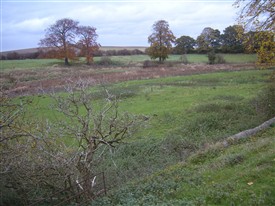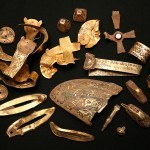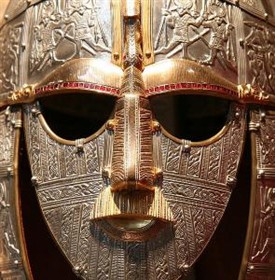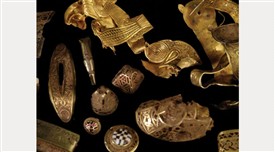Did a King die at Cuckney?

St Mary's Church Cuckney
Ralph Lloyd-Jones

Modern cemetery on site of Cuckney castle
Ralph Lloyd-Jones

River Poulter from St Mary's
Ralph Lloyd-Jones

Paulinus baptising Edwin
Ford Madox Brown, Manchester Town Hall

A small part of the Staffordshire Hoard (bent cross top left)
Staffs County Council

Sutton Hoo helmet
Raedwald?

Another small part of the Hoard
Edwin of Northumbria and the Battle of Hatfield
By Ralph Lloyd-Jones
In 1951 the National Coal Board extended mining operations to just beneath St Mary’s Church, Cuckney. It was necessary to reinforce the foundations of the ancient building, starting by digging six trenches across the nave. A remarkable discovery was made when the contractors unearthed more than 200 skeletons, all of young men, buried together there. Since neither women nor children were present, this looked very like the victims of a major battle which must have once been fought nearby. Unfortunately there was no time for a proper archaeological investigation, although Professor M.W. Barley inspected one of the trenches and wrote a brief report in the Transactions of the Thoroton Society (Vol LX, 1952: 26–29).
Who was this mysterious dead band of brothers? Much of the modern cemetery, which stretches away to the west of the church, is known to be built on the site of a motte and bailey castle, probably late 11th or early 12th Century and associated with the wars of Stephen and Matilda. Yet it seems most unlikely that anyone who lived there would have buried hundreds of men quite literally ‘on their doorstep’. Nor is there any record of a major battle in the area at the time of the castle. The skeletons are almost certainly much older.
In another interesting article, also published in the Transactions of the Thoroton Society (Vol LXXIX, 1975: 40-49), Stanley Revill suggested that they may have been killed at the Battle of Heathfield in 633 A.D. This was when King Edwin of Northumberland was defeated and killed by Penda of Mercia and Cadwalla, King of Gwynedd. In his History of the English Church and People, Bede mentions ‘a fierce battle on the field called Haethfelth on the twelfth of October’, though the Anglo-Saxon Chronicle gives the date as 14th.
‘Heath-’ or ‘Hat-field’ is a common place name meaning simply ‘field of heather’. William Camden the Elizabethan antiquarian decided that the 7th Century battle must have been at the Hatfield which is now a suburb of Doncaster, South Yorkshire. Most significantly, however, there is still a Hatfield Grange just east of Cuckney. In Anglo-Saxon times the whole area between Nottingham and Worksop was heavily forested, so a ‘field of heather’ would have stood out as a suitable place for battle. It is also exactly where armies coming from Northumbria, Gwynedd (North Wales) and Mercia might have converged. Furthermore, since Doncaster was long-established as a Roman town (Danum) it seems likely that any battle fought near there should have been named the Battle of Doncaster, a point which Camden overlooked.
Edwin (c.586 – 633) is important as the first Christian King of Northumbria, baptised by Saint Paulinus in 627. Interestingly he spent some time at the court of his (dubious) ally, Raedwald King of the East Angles, the most likely occupant of the famous Sutton Hoo ship burial. Raedwald had received the Christian sacraments, but if Sutton Hoo is indeed his last resting place, then clearly he had a pagan burial. At the time of the battle Penda of Mercia was definitely a pagan, though the Welsh Cadwalla was supposed to have converted like his enemy Edwin.
Whether the battle was indeed fought at Cuckney, or further north near Doncaster, Edwin’s body was removed by the Northumbrians and taken to York where he had been baptised. Edwinstowe is said to mean ‘Edwin’s resting-place’ and to be where his remains spent the night after the battle; though being to the southeast this seems most unlikely for a Northumbrian army retreating to York. There was also a medieval St Edwin’s Chapel near Warsop, again, clearly named after a person associated with the area, but not necessarily somewhere he actually visited. Having died at the hands of (at least some) pagans, Edwin soon acquired sainthood and his shrine in York became a place of pilgrimage. His feast day is, for obvious reasons, October 12th.
Since the Sutton Hoo dig just before the Second World War, the most significant Anglo-Saxon archaeological discovery has been the Staffordshire Hoard found near Lichfield in 2009. This enormous collection, mainly of bejewelled sword decorations (the iron blades would have been re-used) is thought to have been concealed by one of the Kings of Mercia, possibly Penda. The hoard includes a magnificent gold cross, crumpled out of shape to make it easier to bury. Although this remains conjecture, it is not beyond the bounds of probability that such items were booty taken from the unfortunate Edwin and his men who may have fallen at Cuckney. Only a proper archaeological dig at the church, and on the nearby possible Hatfield Chase battle site, will answer these mysteries from the Dark Ages. Cuckney's skeletons may one day prove the link between the treasures of Sutton Hoo and those of the Staffordshire Hoard.
Further Reading: Transactions of the Thoroton Society are available for reference at most of the county's libraries. Also recommended:
Castles of Nottinghamshire by James Wright (NCC, 2008)